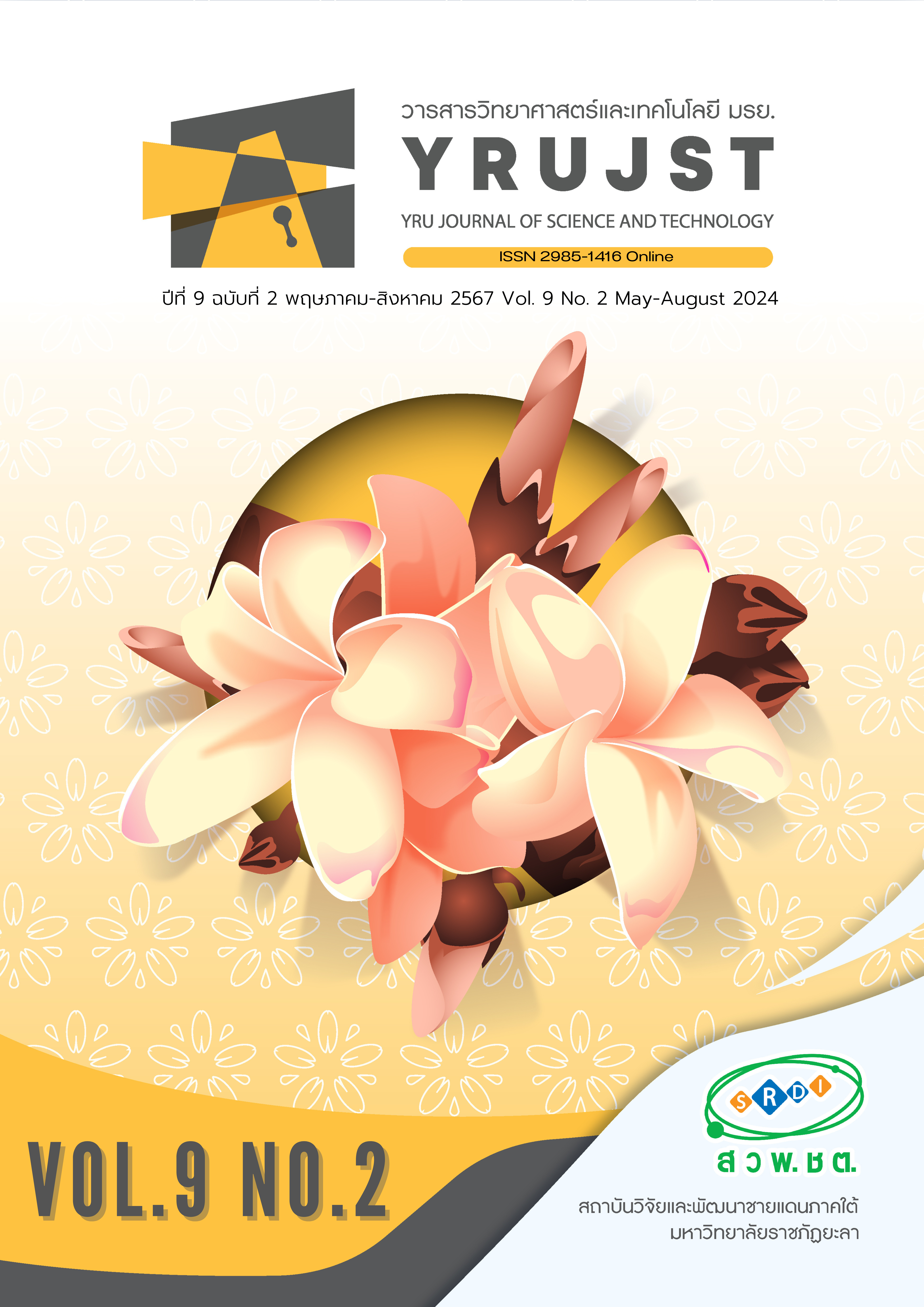การศึกษาสมบัติของแผ่นฉนวนกันความร้อนจากวัสดุเหลือทิ้งทางการเกษตร กรณีศึกษา : ขี้เลื่อย เส้นใยกากมะพร้าว และเส้นใยผักตบชวา
Main Article Content
บทคัดย่อ
วัสดุเหลือทิ้งทางการเกษตรสามารถนำมาประยุกต์ใช้ด้านฉนวนกันความร้อน เนื่องจากมีเส้นใยธรรมชาติที่มีปริมาณเซลลูโลสสูง สำหรับงานวิจัยนี้ได้ทำการศึกษาสมบัติของแผ่นฉนวนกันความร้อนจากวัสดุเหลือทิ้งทางการเกษตร ได้แก่ ขี้เลื่อย เส้นใยกากมะพร้าว และเส้นใยผักตบชวา โดยใช้น้ำยางพาราเป็นตัวประสานในอัตราส่วนของเส้นใยต่อน้ำยางพาราเท่ากับ 60:40 70:30 และ 80:20 และมีขนาดเท่ากับ 16 เซนติเมตร × 16 เซนติเมตร × 2 เซนติเมตร โดยทำการทดสอบ ความหนาแน่น การนำความร้อน สมบัติการต้านทานต่อแรงดึง การดูดซึมน้ำ และสมบัติการลามไฟ ผลการวิจัยพบว่า ความหนาแน่นของฉนวนกันความร้อนมีค่าความหนาแน่นอยู่ในช่วง 315 – 404 กิโลกรัมต่อลูกบาศก์เมตร ฉนวนกันความร้อนจากเส้นใยทุกชนิดและทุกอัตราส่วนมีค่าสัมประสิทธิ์การนำความร้อนที่ต่ำอยู่ในช่วง 0.0136 - 0.0315 วัตต์ต่อเมตร-องศาเคลวิน ค่าการทนต่อแรงดึงอยู่ในช่วง 0.01 - 0.45 เมกกะพาสคัล ค่าการดูดซึมน้ำอยู่ในช่วง 16.49 – 67.64 เปอร์เซ็นต์ และค่าการลามไฟของเส้นใยทั้งสามชนิดเท่ากับ 0 มิลลิเมตรต่อนาที สำหรับฉนวนกันความร้อนที่ดีที่สุดในงานวิจัยนี้เป็นฉนวนกันความร้อนจากเส้นใยผักตบชวาที่อัตราส่วนเท่ากับ 60:40 เนื่องจากมีค่าสัมประสิทธิ์การนำความร้อนที่ต่ำ ค่าการดูดซึมน้ำอยู่ในเกณฑ์มาตรฐานและค่าการทนต่อแรงดึงที่สูงกว่าอัตราส่วนอื่นของเส้นใยชนิดเดียวกัน ดังนั้น วัสดุเหลือทิ้งทางการเกษตรในงานวิจัยนี้ นอกจากสามารถนำมาผลิตเป็นฉนวนกันความร้อนแล้วยังสามารถเพิ่มมูลค่าของวัสดุและยังเป็นฉนวนกันความร้อนที่เป็นมิตรกับสิ่งแวดล้อม
Article Details

อนุญาตภายใต้เงื่อนไข Creative Commons Attribution-NonCommercial-NoDerivatives 4.0 International License.
บทความ ข้อมูล เนื้อหา รูปภาพ ฯลฯ ที่ได้รับการเผยแพร่ในวารสารวิทยาศาสตร์และเทคโนโลยี มรย. นี้ ถือเป็นลิขสิทธิ์ของวารสารวิทยาศาสตร์และเทคโนโลยี มรย. หากบุคคลหรือหน่วยงานใดต้องการนำทั้งหมดหรือส่วนหนึ่งส่วนใดไปเผยแพร่ต่อหรือกระทำการใดๆ จะต้องได้รับอนุญาตเป็นลายลักษณ์อักษรจากวารสารวิทยาศาสตร์และเทคโนโลยี มรย. ก่อนเท่านั้น
เอกสารอ้างอิง
Anh, L. & Pasztory. Z. (2021). An overview of factors influencing thermal conductivity of building insulation materials. Journal of Building Engineering, 44(102604), 1-16.
Bumanis, G., Argalis, P., Sahmenko, G., Mironovs, D. Rucevskis, S. Korjakins, A. & Bajare, D. (2023). Thermal and sound insulation properties of recycled expanded polystyrene granule and gypsum composites. Recycling, 8, 1-12.
Gonzalez-Torres, M., Perez-Lombard, L., Coronel, J., Maestre, I. & Yan, D. (2022). A review on building energy information: Trends, end-uses, fuels and drivers. Energy Report, 8, 626-637.
He, Q., Fei, H., Zhou, J., Liang, X. & Pan, Y. (2023). Utilization of carbonized water hyacinth for effective encapsulation and thermal conductivity enhancement of phase change energy storage materials. Construction and Building Materials, 372, 130841.
Jensen, P., Belmonte, L., Solvang, M. & Yue, Y. (2023). Quantification of high temperature stability of mineral wool for fire-safe insulation. Journal of Non-Crystalline Solids, 622, 122680.
Jiang, D., Lv, S., Cui, S., Sun, S., Sonf, X., He, S., Zhang, J. & An, P. (2020). Effect of thermal insulation components on physical and mechanical properties of plant fibre composite thermal insulation mortar. Journal of Materials Research and Technology, 9(6), 12996-13013.
Jaktorn, C. & Jiajitsawat, S. (2014). Production of Thermal Insulator from Water Hyacinth Fiber and Natural Rubber Latex. NU. International Journal of Science, 11(2), 31-41.
Jarunjaruphat, N. & Acharry, S. (2018). The particleboard manufacturing from agricultural waste. The Journal of KMUTNB, 28(2), 469-476. (in Thai)
Kamran, M., Yan, Z., Ahmad, I., Jia, Q., Ghani, M., Chen, X., Chang, S., Li, T., Siddique, K., Fahad, S. & Hou, F. (2023). Assessment of greenhouse gases emission, global warming potential and net ecosystem economic benefits from wheat field with reduced irrigation and nitrogen management in an arid region of China. Agriculture, Ecosystems and Environment, 341, 108197.
Khamput, P. (2022). Using rubber wood chips, rubber leaves and rubber latex as a heat insulating wall system. Journal of Engineering, RMUTT, 20(1), 13-24. (in Thai)
Lojareonrat, W. (2006). The production of thermal insulation from rice straw fiber and natural rubber latex. Kasetsart Engineering Journal, 57(19), 32-45.
Maafa, I., Abutaleb, A., Zouli, N., Zeyad, A., Yousef, A. & Ahmed, M. (2023). Effect of agricultural biomass wastes on thermal insulation and self-cleaning of fired bricks. Journal of Materials Research and Teachnology, 24, 4060-4073.
Mehrzad, S., Taban, E., Soltani, P., Samaei, S. & Khavanin, A. (2022). Sugarcane bagasse waste fibers as novel thermal insulation and sound-absorbing materials for application in sustainable buildings. Building and Environment, 108753.
Mohamed, G., Mamoud, R., Fahim, S., Shaban, M., Abd El-Salam, H. & Mahmoud, M. (2021). Bio-composite thermal insulation materials based on banana leaves fibers and polystyrene: physical and thermal performance. Journal of Natural Fibers, 1-16.
Monireh, F., Ebrahim, T., Parham, S., Umberto, B., Ali, K. & Vida, Z. (2023). Waste corn husk fibers for sounds absorption and thermal insulation applications: A step towards sustainable buildings. Journals of Building Engineering, 77(107468), 1-12.
Ramphueiphad, S., Jaruwongwittaya, T., Toolthaisong. S., Amattirat, N. & Boonjue, A. (2015). Thermal insulator produced from polyurethane and hevea brasiliensis. Farm Engineering and Automation Technolongy Journal, 1(2), 75-81. (in Thai)
Sakulpanich, A. (2016). The development of building thermal insulation from corncob and natural rubber latex. Veridian E-Journal, Silpakorn University (Humanities, Social Sciences and Arts), 9(1), 1906-3431. (in Thai)
Saueprasearsit, P., Boonchaleaw, C. & Junsiri, S. (2020). Technical feasibility for thermal insulation production from durian peel. J Sci Technol MSU, 39(6), 664-671. (in Thai)
Sen, S., Singh, A., Bera, C., Roy, S. & Kailasam, K. (2022). Recent developments in biomass derived cellulose aerogel materials for thermal insulation application: a review. Cellolose, 29, 4805-4833.
Sudprasert, S. (2018). Simulation study of air-conditioning energy consumption and payback period of using thermal insulation in the detached houses. Journal of The Faculty of Architecture King Mongkut's Institute of Technology Ladkrabang, 27(1), 193-204. (in Thai)
Sun, J., Cai, F., Tao, D., Ni, Q. & Fu, Y. (2021). Enhanced thermal insulation of the hollow glass microsphere/glass fiber fabric textile composite material. Polymers, 13, 1-10.
Tamhi, A. & Tuntiwaranuruk, U. (2018). Thermal conductivity of heat insulators produced from pandan fiber and water natural rubber. King Mongkut's Agricultural Journal, 36(3), 117-124. (in Thai)
Thilagavathi, G., Muthukumar, N. & Neela Krishnanan, T. (2019). Development and characterization of pineapple fibre nonwovens for thermal and sound insulation applications. Journal of Natural Fibers, 17(10), 1-10.
Tangjuank, S., Wansao, C., Bunyarattaphan, N., Mahanil, W. & Marak, K. (2023). Thermal insulation board from rice husk and sawdust using natural rubber latex as binder. Udon Thani Rajabhat University Journal of Sciences and Technology, 11(2), 51-68. (in Thai)
Tuntiwaranuruk, U. & Lekjaisue, C. (2017). Thermal properties for thermal insulation from earth ginger (Etlingera littoralis Gieseke). King Mongkut's Agricultural Journal, 35(1), 102-108. (in Thai)
Wang, R., Lu, S., Zhai, X. & Feng, W. (2022). The energy performance and passive survivability of high thermal insulation buildings in future climate scenarios. Build Simul, 15, 1209-1225.
Wansao, C., Bunyarattaphan, N. & Tangjuank, S. (2021). Preparation of artificial wood from plastic and coir fiber. Journal of Kanchanaburi Rajabhat University, 10(2), 295-309. (in Thai)
Zemla, M., Prociak, A., Michalowski, S., Cabulis, U., Kirpluks, M. & Simakovs, K. (2022). Thermal insulating rigid polyurethane foams with bio-polyol from rapeseed oil modified by phosphorus additive and reactive flame retardants. International Journal of Molecular Sciences, 23, 12386.
Zhang, M., Wang, D., Li, T., Jiang, J., Bai, H., Wang, S., Wang, Y. & Dong, W. (2023). Multifunctional flame-retardant, thermal insulation, and antimicrobial wood-based composites. Bio macromolecules, 24, 957-966.


